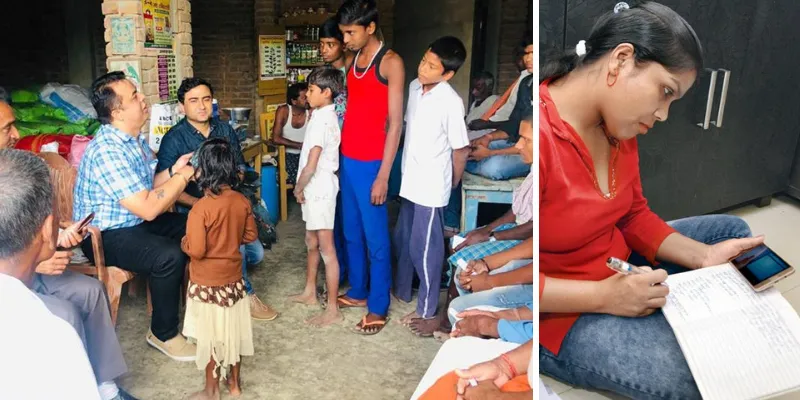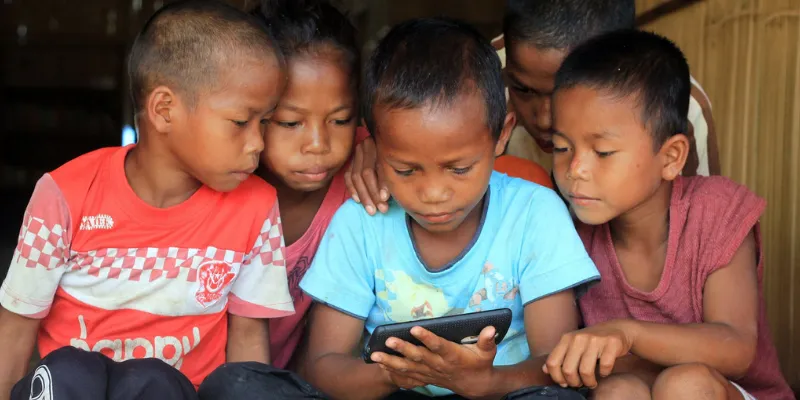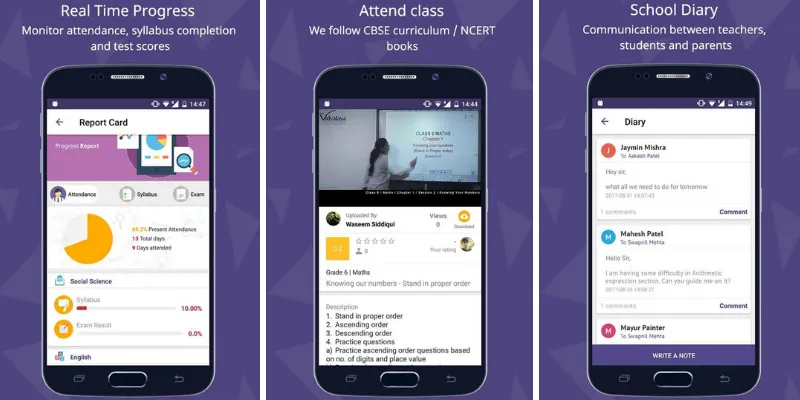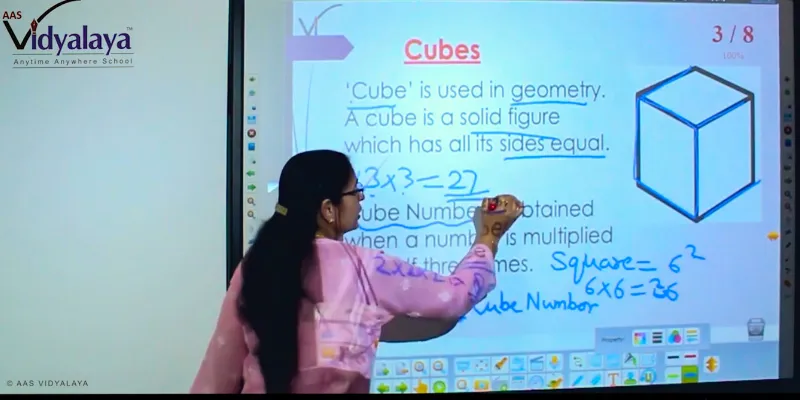From J&K to Bihar, this app lets students attend Anytime Anywhere School on their phones
Founded in aeptember 2017, Mumbai-based AAS Vidyalaya offers course-work for students of classes six to ten; Founder Vikas Kakwani says the virtual platform will help Bharat meet India.

Schooling isn’t easy in Jammu and Kashmir as continued violence and unrest often leads to shutdowns. In 2016-2017, following the death of militant commander Burhan Wani, the Kashmir valley faced a complete shutdown for 130 days, shutting down schools and bringing learning to a standstill. That’s when Vikas Kakwani decided that if students couldn’t come to the school, the school would go to the students.
Vikas, 44, an IIT-IIM graduate, is the Founder of AAS Vidyalaya, which aims to be a game-changer with its “Anytime Anywhere School” concept.
“Recently, there were incidents of schools being burnt down by extremists. All this affects education. If children are educated, there is a reduced likelihood of them taking the path of violence in the future. This is precisely the reason why extremists target schools; they don’t want children to be educated,” he says.
Vikas founded AAS Vidyalaya in September 2017 to help children everywhere continue their schooling. Accessible through a smartphone, the user needs initial access to the internet to download classes, after which the child can watch them offline. So, even if the internet is blocked during unrest, classes can continue.
With a strength of 500 students in a year, the AAS Vidyalaya app is gaining strength and recognition across J&K through word of mouth.
“Pehle meri beti iss aas (hope) pe rehti thi ki kab school khulega aur ab vo AAS (Vidyalaya) mein padhti hai,” says the father of Safina*, who is presently studying in Class 7.
“The Anytime Anywhere School, a mobile app that aims to be India’s first virtual school, is solving the problem of availability and accessibility of quality education. We work by bringing the school to the children instead of children to the school,” Vikas says.
Presently, this e-learning school is offering education opportunities for classes six to 10 with the CBSE curriculum. It offers courses under the Open Basic Education (OBE) programme, Level C, National Institute of Open Schooling.
But it’s not just J&K that needs virtual schooling.

AAS Vidyalaya claims to have received registrations from over 1,800 towns and villages across India, primarily concentrated in Madhya Pradesh, Uttar Pradesh, Bihar, and the Northeastern states.
E-learning for Bharat
Vikas, through the virtual learning platform, hopes to make “Bharat meet India”. “India refers to the urban, westernised populace comprising high-income, English-speaking city dwellers. Bharat, on the other hand, is the rapidly rising middle-income populace living generally in smaller towns and villages. Bharat is modern, but not Western. Bharat is aspirational, converses in vernacular, has seen rising income levels over the last couple of decades, and has got exposed to the world through internet on mobiles.”
Of the 250 million who should be in schools, 85 million children are out of school for various reasons, ranging from working for a living to insufficient funds. Apart from long travel hours needed to reach school, many don’t have access to basic infrastructure such as roads, toilets, electricity, books etc.
“Weighed down by the challenges of a developing nation, this is the aspirational class, waiting for a product to meet their needs. Conversely, the education system largely concentrates on making technology better for the ‘studying' masses through advancements like smart classes, A/V sessions, e-learning, etc. Mumbai-based AAS Vidyalaya, on the other hand, is dedicated towards catering to the latent need of the masses, thereby educating those who lack access and availability of education,” Vikas says.

Built as a mobile application targeting the middle and lower-middle classes, the app hopes to reach the 85 million children who wish to – but cannot - attend school.
For this, Vikas is leveraging the smartphone user base in India, which is slated to grow from 300 million to over 650 million by 2019.
“Our target audience is voraciously consuming video content since it got hold of cheap and fast 4G network. Through digital marketing we are able to reach students and parents who are already on their mobile devices and consuming digital content. Within three months of launch we have been able to reduce our cost of acquisition to only Rs 2.80 per user,” Vikas shares.
Learn on the go
The virtual school simulates a real classroom with syllabus, time-table, class teachers, and subject teachers. It has a guided course structure with lectures, notes, and Q&As with facility of direct interaction with teachers. Mentors, in the form of class teachers, guide, monitor progress, and motivate children throughout the course. Regular assessments and feedback are given to evaluate a child’s learning and tracking her progress. Progress of the child is measured on three parameters: attendance, syllabus completion, and test performance.

The app also enables transparency for parents to monitor the progress of the child in real time and reach out to teachers, who receive online training, for discussions. A class teacher is assigned to each student based on the child’s location and language preference.
Vidya Ganesh, a teacher with over 20 years of experience, teaches high school students through the app.
She says: “The other day just as I was buying the veggies from my vendor, I told him about the app. Curious, he took his cart aside, handed me his phone, and asked me to download the app. The women nearby also gathered around, curious to know more. That day, I really felt the power of the app and the change journey we are embarking on. Right to education is a necessity, it should not be restricted.”
The virtual learning platform is also helping children to gain additional support in learning as the app acts like an online tuition for school-going students.
Sonu Gupta, a Class 8 student, says, “I can’t understand what the English teacher in my school teaches. I can come back home and do revision as well as ask my doubts without being scared.”

With a bootstrap investment of Rs 1.5 crore, the organisation offers students of Class 6-8 access to courses in all subjects for a subscription fee of Rs 299 per month. If they need coaching in one subject, the fee is Rs 99 per month for one subject. The courses for Classes 9 and 10 are priced at Rs 499 per month for all subjects or Rs 199 per month for one subject.
From virtual to physical
The school may be completely virtual as of now, but the team of four plans to set up physical centres that will use a hybrid model. There will be two types of centres:
- Institutes powered by AAS Vidyalaya: Existing institutions such as government schools and NGOs using AAS Vidyalaya’s platform to teach students; and
- AAS Vidyalaya education zones: Here, with the help of minimal infrastructure and a facilitator, students can come and attend classes as per their convenience.
Vikas lists out the challenges ahead: Lack of 300,000 secondary schools, high commuting hours needed each day to reach school, 8.4 crore children not attending schools, 35 percent average drop-out rate, 52 percent average attendance in secondary classes, and 25 percent teacher absenteeism.
“These are challenges that require huge investment on infrastructure to ensure decent quality of education. E-learning provides a unique opportunity to solve the problem with the use of technology. The only way India can benefit from its demographic dividend is when everyone in the country is educated,” Vikas says.







